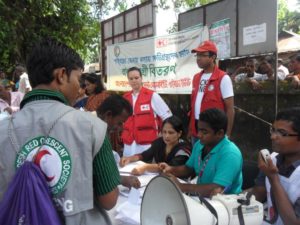This is a post by Wendy Brightman, who is a volunteer from Alaska spending four weeks in Bangladesh helping with cash transfer programming after severe flooding left millions displaced and hundreds of thousands of homes destroyed.

I landed at 8 AM Tuesday morning in Dhaka, Bangladesh. I am fascinated with the country; it’s my first visit. I head to the office and begin discussing plans for the next few weeks. I’m here to learn about how the Cash Transfer Program in Emergencies—run by the Bangladesh Red Crescent Society (BDRCS) along with the International Red Cross Federation—operates.
I start the next day visiting cash distribution sites. The flooding is pervasive in the northern districts of Bangladesh. As the icepack in the Himalayas melts, it flows from Nepal through tributaries in India to the large Jamuna River that flows through Central Bangladesh. Since the amount of snow and rainfall can vary from year to year, flooding doesn’t always occur. Yet, its potential is on always the minds of Bangladeshi people.
We spend three days at various distribution sites, observing cash being distributed in envelopes directly to beneficiaries. Each beneficiary receives 2,000 Taka (about $25 USD)—the value of the dry food packet that BDRCS normally distributes to people after a disaster. It is approximately two thirds of a laborer’s monthly salary. The process is well organized and peaceful. The volunteers, employees, and beneficiaries have been well informed about the program and what is happening.
I interview a few of the beneficiaries to ask how the flood affected them, what they would spend their unconditional cash grant on, and if they felt safe receiving this money since it was almost one month of salary. They answer their homes were mostly destroyed or partially lost, their rice paddies were flooded and the crop lost, or their livestock drowned. Many will use their money for home repairs, food, or restarting their livelihoods. The women beneficiaries confidently told me they travelled in groups of 5-7 from their homes. They felt quite comfortable travelling with their cash. Since the flooding is only in certain areas along the river, markets further in land are functioning. Though they may have to travel further to purchase their items, the beneficiaries do not seem to mind this small inconvenience.
Overall, BDRCS and Federation staff advocate for the use of cash. They can respond within one week to a flood whereas before it would take sometimes up to three weeks to organize and distribute supplies to beneficiaries. Cash is versatile and the beneficiaries can buy what they need in the local markets.
Yet, BDRCS keeps a ready stock of supplies for contingency or supplementation. They rely on their local volunteers to give a clear picture of what is needed in the affected communities. This needs assessment guides the distribution decisions. Often the decision is to use cash and items as a mixed packet for the beneficiaries.
Next week we head out to see the beginning of the recovery programs in the southern districts. The Red Cross will be distributing cash to beneficiaries by transferring funds to their already established bank accounts. I’m sure the trip will be just as educational as the previous week!
